25 Years of Loud, Expensive Space Heaters.
A half-written draft of this piece has been living on my HDD for nearly half a year. Recent discussions re: the subject of "aging and death of PC irons" prompted me to dust it off and quickly post. Regularly-scheduled programming will resume shortly...
"The tools, the means and the methods disappear under the overwhelming dead weight of simulacra and cvasi-originals nobody knows how to distinguish from the genuine article anymore long before the activities they used to support are altogether renounced as such. That's be why you're still pretending to be engaging in computing long after the last computers became unavailable to you. That's why you can't buy silk anything, that's also why I have to argue with the clerks over cotton socks ("oh, it only says 80% cotton 20% synthetic" "right" "that's the elastic, you don't want socks without elastic like for diabethics do you ? the kind that crumple around the ankle and don't stay up ?" "..." They're always shocked when they proclaim so and so article "no longer exists" and I point out I'm wearing it."
-- Mircea Popescu, "Domestic casting"
"...why are we even _thinking_ about home computer equipment when we wish to attract professional programmers? in _every_ field I know, the difference between the professional and the mass market is so large that Joe Blow wouldn't believe the two could coexist. more often than not, you can't even get the professional quality unless you sign a major agreement with the vendor — such is the investment on both sides of the table.... ...they don't make poles long enough for me want to touch Microsoft products, and I don't want any mass-marketed game-playing device or Windows appliance _near_ my desk or on my network. this is my _workbench_, dammit, it's not a pretty box to impress people with graphics and sounds. when I work at this system up to 12 hours a day, I'm profoundly uninterested in what user interface a novice user would prefer."
-- Erik Naggum
As a boy, I had one of these "breadboxes":
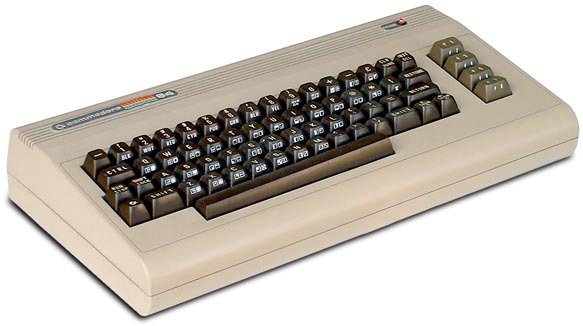
This small but nearly perfect "micro" came with full electronic schematics, and was a joy to use. But, more pertinently to the subject at hand, it ate less than 10 watts of current at peak load, and consequently needed no forced air cooling:
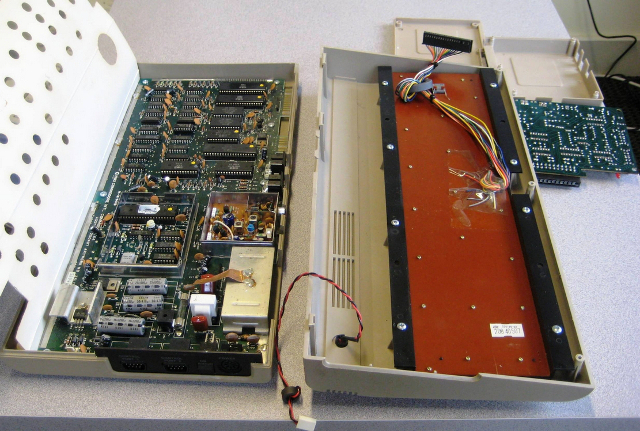
You could hear the birds sing while using the Commodore.
After this, came the time of the ubiquitous 486 "AT" towers, where already the power supply blower could be heard from across the room...

... but at least the CPU needed no fan of its own:
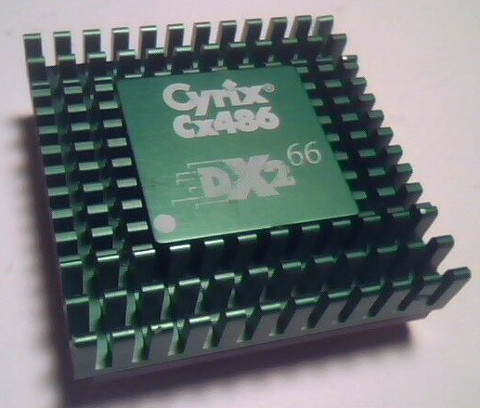
And then, came the "Pentiums" etc., and suddenly it was considered acceptable for a desktop computer to sound like a vacuum cleaner and draw in similar quantities of dust.
I have always despised the CPU fan. Possibly because -- in spite of living for many years in the "country of the deaf" -- I did not partake in their peculiar heathen ritual whereby they blow away their high-frequency hearing (this thing they call "concerts".)
When I first began to work for serious pay, soon enough I was able to build a "workstation" (in my conception, a workstation is a machine that you expect to work with, daily, and consequently ought to consist of the best components that your money can buy.) But the idea that such a machine ought to loudly suck in several liters of air and dust every second, I found quite offputting. And so, went and purchased a Toyota radiator, and ended up with this:
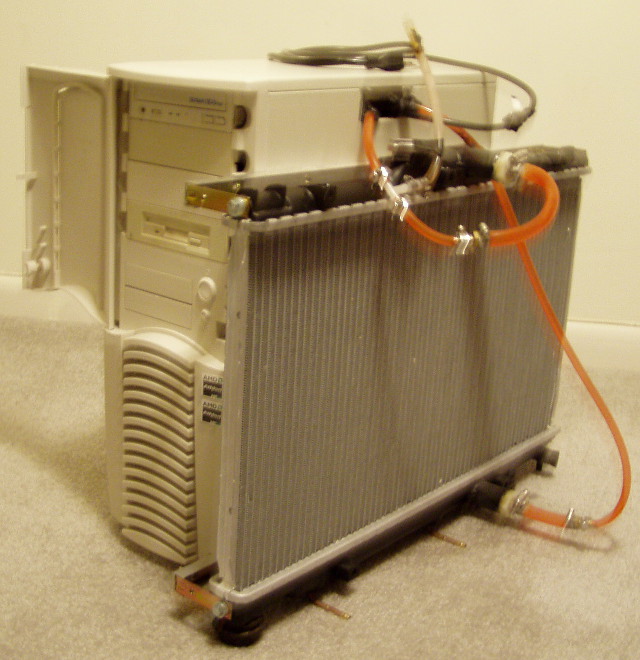
There was nothing "overclocked" inside the pictured dual-"Athlon" box. The experiment with piped water was intended strictly for noise-deadening and "uptime" (i.e. avoid disassembly for cleaning) :
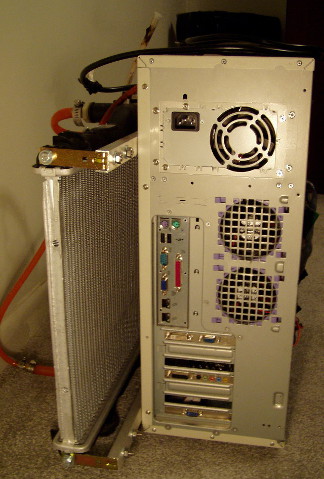
After a few days of temperature measurements, I proceeded to remove the two fans which came with the chassis. But there still remained the one in the power supply. Initially I thought to fill the latter with transformer oil and seal a copper heat exchanger coil inside; but at the time did not have a welder, and so it stood as it were.
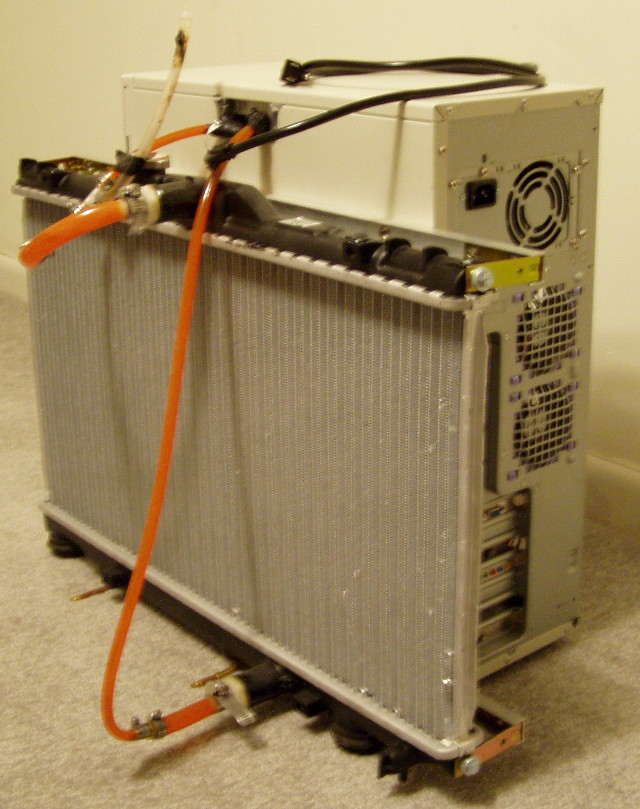
Prefab "water blocks" for various CPU had just appeared on the market, so it was not necessary to make them by hand:
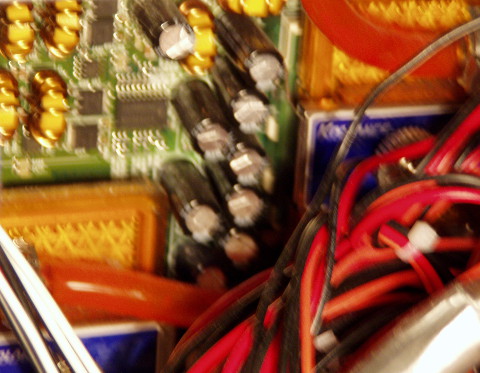
Pumps specifically built for this purpose, however, were not available, so the chosen pump was of the sealed magnetic type used in fish ponds. It circulated about 4 litres of distilled water + antifungal:
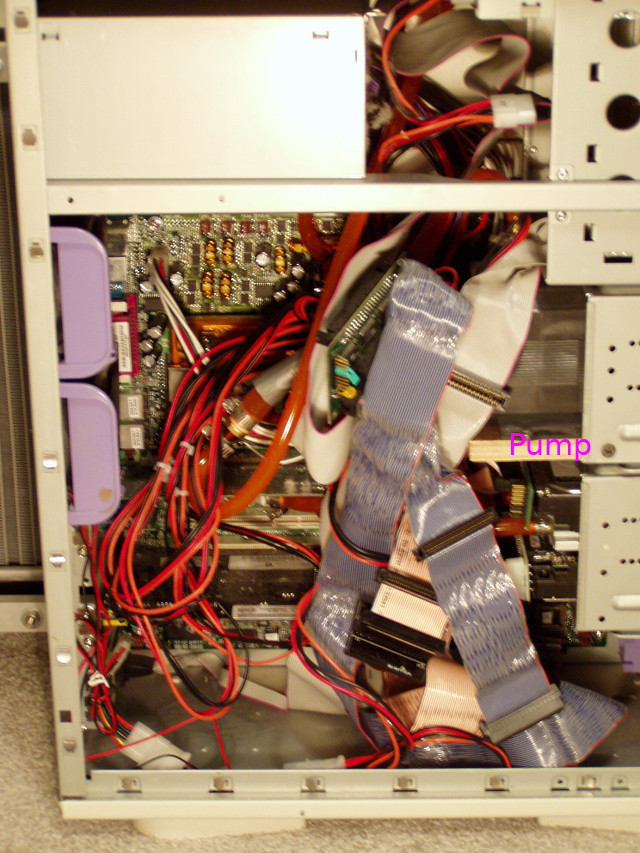
HDD water block:
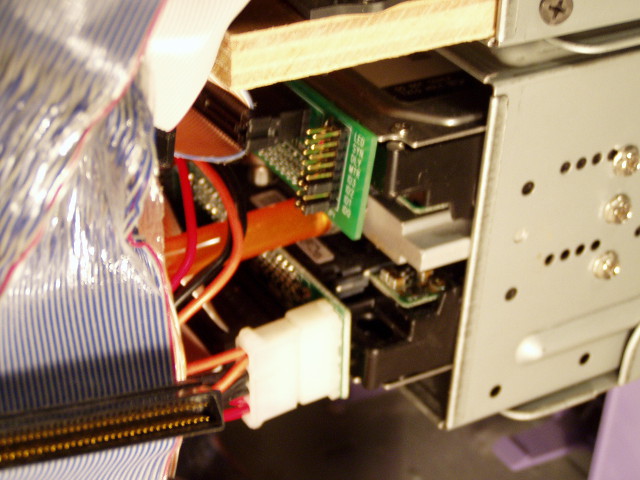
And video card...
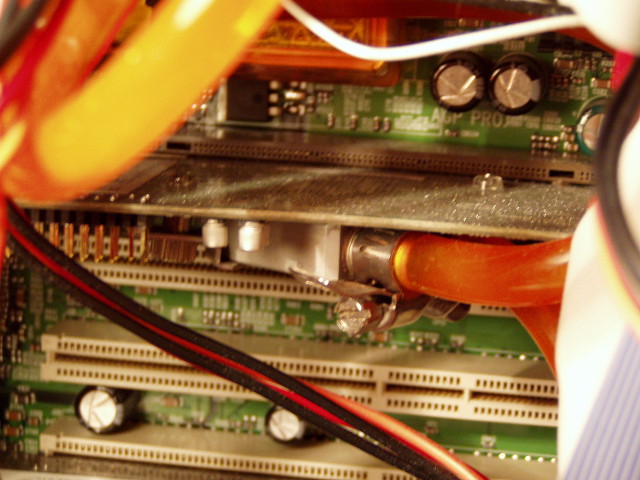
... which, some five years later, developed a leak and drowned the machine. Rubber hoses with compression fittings are not a reliable component.
The reader is invited to point and laugh at the author's folly.
After this, and to this day, I live with the whine of fans, just like everyone else. And yes it is possible to buy "quiet" fans. But when there are six or seven of them, and you run your machine 24/7 (with, remember, two -- or even four -- CPUs, a full "server" board's worth of RAM, etc., it's after all a workstation, you work on it...) , and at full CPU load in the night (why would you want to have idle cycles in your workstation? you paid for it, let it work!) and dust slowly accumulates...
Eventually, the airflow slows, the two (or if you're "loaded", four, or more...) 200 watt processors begin to warm the "oven", and capacitors -- pop.
And if you, like me, use strictly pre-NSA-Fritzchip "egg boiler" AMD irons, you will be in search of a costly and potentially-unobtainable set of replacement parts.
It is here that I must point out that there is nothing physically impossible, or even especially difficult, about constructing a hermetically sealed electrical machine which disposes of multiple kilowatts of waste heat via adequate passive cooling.
Your local power company fields thousands of them:

In the early 2000s, Korean company "Zalman" marketed a kit for constructing a dust-sucker-free PC:
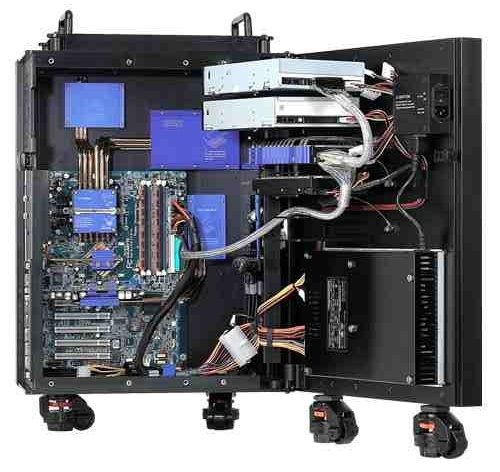
This was a pretty solid item, 40kg or so of "hedgehog" thermal mass, at several thousand $. Unfortunately, "Zalman" folded before it could mass-produce a multi-CPU variant of this system.
A roughly similar item is apparently still sold today:
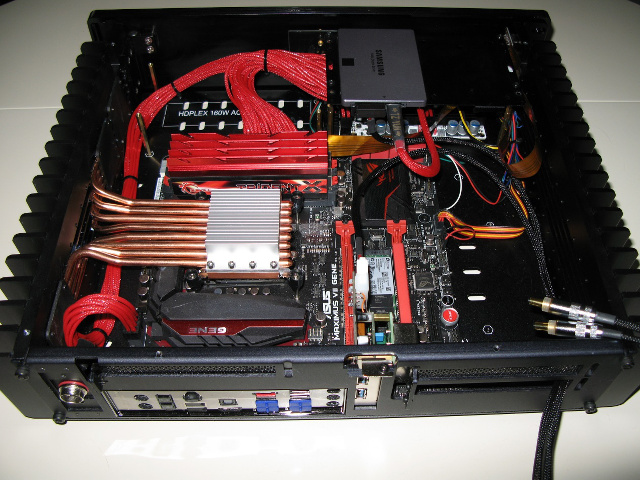
... but it is of course a "consumer" piece of rubbish, limited to a single (and underpowered) CPU, on account of a laughably-inadequate "hedgehog".
If anyone were to market a "mains transformer"-style 100%-passively-cooled chassis for serious workstations -- I would buy it. I do not care if it were to have the size, weight, and cost of an upright piano. (I expect, on purely physical grounds, that it must -- especially if built with a 2-3x engineering margin.)
A PC workstation that could be radiosnoop-shielded, filled with inert gas, and welded shut -- and reliably expected to work for decades, would IMHO be a quite serious advance -- in a market where serious advances have been conspicuously absent for many years.



There are passive PSUs, and ones with fans that won't spin up until 50% load (multiple PSUs?). There are big passive CPU coolers.
With regard to the AMD chips, https://www.raptorcs.com/TALOSII/? CPU waterblocks for it are available for individuals though.
Zalman's still around, but they don't do that kind of passive cooling anymore. The TNN 500AF originally cost $1,500 I think. Last build I saw with it is http://www.neo-geo.com/personal/i5-fanless/build2.html.
The king of radiators is the German Gigant 3360 which is much better than Zalman's upright Reserators from the same time period.
The Calyos NSG S0 was a working prototype with no noise, but they folded with the remnants going to https://www.monsterlabo.com/.
There is also always the option to do immersion cooling with mineral oil in a fish tank (https://linustechtips.com/main/profile/216771-stefan1024/) or with https://www.3m.com/3M/en_US/novec/products/engineered-fluids/immersion-cooling/ used in servers.
https://www.silentmaxx.de/
https://www.deltatronic.de/en/
https://www.haxx.eu/start-english/pc-case-0-1/
These are closest things that you can buy that I'm aware of.
Dear James Nguyen,
I've tried several "passive" PSUs. They tend to die after a year or two, in my experience. Observe that Zalman made theirs in a "flat" form factor, rather than the usual ATX. The latter seems to presume a large airflow from case fan, in order to stay at the rated temperature.
As for the PSU with variable-speed fans, they run at max speed in my machines (because, again, these machines draw close to their theoretical max current just about always.)
Interesting passive-heatsink links, but they do all seem to fall into the category of the "A roughly similar item..." linked earlier -- none of them, near as I can tell, will work with even a single 200W Opteron, much less two.
I've seen the gigantic CPU heat sinks, they've been around for some years. There is even one, IIRC, that fits Opteron. But these won't work on a dual or quad-CPU board, they take up too much horizontal space.
I'm aware that liquid thermoblocks are still sold. But for me, one drowned machine is quite enough.
Re: immersions, 3M's "Fluorinert" has been around since 1980s. But if you add up the cost of filling a full tower cabinet with it, you will find that it is actually cheaper to have a Zalman-style solid heat sink machined to fit your boards (in either case, 20-30K $ or so.)
Yours,
-S
Nowadays one can find passive cooled Xeon / Core-i9 boxes with up to 128 GB of RAM:
https://www.compulab.com/products/embedded-pcs/
https://www.logicsupply.com/eu-en/computers/industrial/fanless/
They would make an excellent, albeit expensive, workstation for pretty much anyone.
The problem though, is that all these come with chips laden with Intel ME, and thus unfit for Stanislav's standards.
Stanislav, I guess you have no other way besides ordering custom machined parts for your beloved Opterons. However, I guess it will be much easier to find people to share that cost with you, if you instead ditch the Opterons in favor of some POWER9 CPUs. Ask around at #talos-workstation
Dear dllud,
Intelisms aside, these boxen are pretty spartan (i.e. you won't be fitting a "3ware" RAID card with 8 SSD's in one; or 2nd CPU; or 256G of ECC RAM; etc.)
Re the Talos/POWER9 people -- I'm still curious how and why anyone thinks a single-source (IBM) processor is supposed to be a demonstrable improvement over Intel's NSAware. They cost their weight in gold, too. Always seemed like a chump bait / honeypot scheme to me.
Yours,
-S
I agree with your frustration, Stanislav. I would much prefer to have a weaker machine that required no fan than the current set that are available, where a noisy fan is usually included. Some fans are much easier on the ears than others, though, and there are some laptops that contain no fans and also don't seem to suffer unnecessary heating otherwise.
I use a laptop for a suitable main machine because I don't have requirements that require more memory or cycles than can be provided, however. There's the argument that using a ``lesser'' machine for development encourages more efficient programs, but that line of thinking is to me similar to setting a clock incorrectly because one lacks proper discipline and self-control; it's not entirely bad, in any case.
As for having sealed machines, that has obvious auditing issues and I've mostly seen others discuss such machines in terms of handheld devices and only then for preventing any manner of inspection or modification or for saving fools who drop their devices in water.
In closing, some groups preaching energy efficiency have spread their messages far and wide lately, but proper conclusions, such as specialized machines and whatnot, don't seem to be among these; the arguments tend toward recycling more than anything, not to write that's poor, either. Still, this may be the venue some good change travels through.